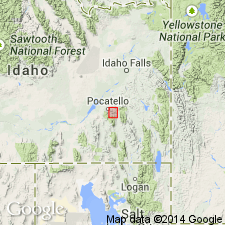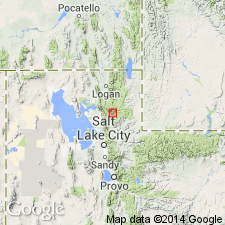
- Usage in publication:
-
- Pocatello formation
- Modifications:
-
- Named
- Dominant lithology:
-
- Tillite
- Slate
- AAPG geologic province:
-
- Northern Rocky Mountain region
Summary:
Pg. 89-92. Pocatello formation. Thick series of unfossiliferous metamorphosed sediments. Considerable variations in thickness and distribution of component sediments. Divided into two series: lower tillite series consisting of silicified sandstones, slates, intraformational limestone conglomerate, thin-bedded metamorphosed limestones, argillites, and tillites, approx. 1,100 feet thick; and an upper varved slate series consisting of alternating bands of dark and light slate with a few thin beds of sandstone in upper part, 350 feet thick. Underlies Blackrock limestone. Overlies Bannock volcanic formation of which it was formerly a part. Age is Precambrian.
Exposed in Pocatello quadrangle, southeastern ID. [Type locality not designated. Named from town of Pocatello in Bannock Co., ID (Northern Rocky Mountain region).]
Source: US geologic names lexicon (USGS Bull. 1200, p. 374); supplemental information (in brackets) from GNU records (USGS DDS-6; Denver GNULEX).

- Usage in publication:
-
- Pocatello Formation*
- Modifications:
-
- Revised
- AAPG geologic province:
-
- Northern Rocky Mountain region
Summary:
In Pocatello area, Bannock County, southeastern Idaho, Pocatello Formation is revised to include (ascending): unnamed lower member, Bannock Volcanic Member (revised), Scout Mountain Member (new), and unnamed upper member. Lower member consists of black, thinly laminated, slaty argillite, phyllite, siltite, and brown quartzite; thickness about 700 feet. Bannock Volcanic Member consists of volcanic flows and breccias at least 1,000 feet thick; [underlies and/or interfingers with?] Scout Mountain. Scout Mountain Member consists of limestone, quartzite, siltite, and diamictite, several thousand feet thick. Upper member consists of thinly laminated phyllitic to slaty argillite, and in upper part, quartzite; thickness 2,000 feet. Formation is of probable marine origin. Underlies Blackrock Canyon Limestone (renamed). Is the oldest unit in the Pocatello area. Age is Precambrian. (Pocatello Formation is adopted by the USGS.)
[Discrepancy: GNU records (USGS DDS-6, Denver GNULEX, and US geologic names lexicon, USGS Bull. 1520, p. 274) indicate the Bannock Volcanic Member "interfingers with" and "is equivalent to" the Scout Mountain Member. GNC records (USGS Bull. 1372-A, p. A3, A17) indicate the Bannock Volcanic Member "underlies" the Scout Mountain Member. --unresolved.]
Source: GNU records (USGS DDS-6; Denver GNULEX); Changes in stratigraphic nomenclature, 1971 (USGS Bull. 1372-A, p. A14-A15).
For more information, please contact Nancy Stamm, Geologic Names Committee Secretary.
Asterisk (*) indicates published by U.S. Geological Survey authors.
"No current usage" (†) implies that a name has been abandoned or has fallen into disuse. Former usage and, if known, replacement name given in parentheses ( ).
Slash (/) indicates name conflicts with nomenclatural guidelines (CSN, 1933; ACSN, 1961, 1970; NACSN, 1983, 2005, 2021). May be explained within brackets ([ ]).

